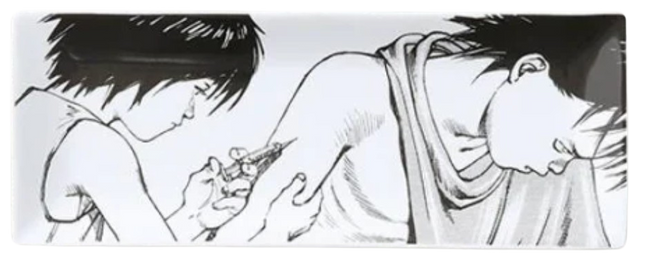
Japan


Supreme Akira Syringe Ceramic Plate Tray Art Object by Supreme
Akira Syringe Ceramic Plate Tray Art Object by Supreme Limited Edition Collectors Dish Artwork. 2017 Stamped Limited Edition Supreme Ceramic Tray Plate Artwork Size 11.25x4.25 Collectible Art Object. Supreme AKIRA Syringe Ceramic Tray: A Cult Classic Revived in Porcelain The Supreme AKIRA Syringe Ceramic Tray stands as a cultural artifact that weaves together the rawness of street pop art with the meticulous detail of manga illustrations. Released as a highly anticipated part of the Fall/Winter 2017 collection, this limited-edition tray encapsulates the edgy essence of the Supreme brand while paying homage to the trailblazing Japanese manga AKIRA. Crafted with precision, the white ceramic tray is a testament to the enduring influence of the manga series and the ingenious adaptability of Supreme's streetwear aesthetic. The tray, measuring 11.25 inches by 4.25 inches, is a canvas that brings the stark black-and-white world of AKIRA's neo-Tokyo into the tangible realm. It features an intense scene directly lifted from the pages of the manga, depicting the characters Kaneda and Tetsuo in a moment fraught with tension, where Tetsuo is administered an injection. This scene is a pivotal point in the AKIRA series and a snapshot of the intricate and action-packed storytelling that has captivated fans for decades. Ceramic Artistry Meets Iconic Graphic Storytelling The synergy of Supreme's branding and AKIRA's graphic artwork on the Supreme AKIRA Syringe Ceramic Tray is a striking example of how street pop art can merge with other media to create something new yet familiar. Supreme's subtle insertion of its name onto the syringe in the artwork exhibits a clever interplay between brand identity and narrative imagery. This detail, while minor, is a deliberate nod to the collaborative nature of the piece and signifies a merging of worlds that both Supreme and AKIRA fans can appreciate. Beneath the tray lies the iconic Supreme box logo, a signature that asserts the item's authenticity and ties it back to the lineage of Supreme's previous collectible items. This emblem, juxtaposed with the manga artwork, bridges the cultural zeitgeist of modern streetwear with the classic artistry of Japanese manga. The logo's presence is a pledge of quality and a symbol that resonates with collectors who understand the worth of limited-edition street pop art. Impact and Collectibility of the Supreme AKIRA Syringe Tray The Supreme AKIRA Syringe Ceramic Tray is more than a mere decorative piece; it's a slice of pop culture history molded from ceramic. The decision to immortalize this particular manga scene in the form of a high-quality tray demonstrates a nuanced understanding of the collector's mindset—it is not merely the object of value but the convergence of art, narrative, and brand that makes it a treasure. As a collectible, the tray commands attention, serving as a focal point that ignites conversations about street pop art, its intersections with other forms of media, and the very nature of contemporary collectibles. In street pop art and graffiti artwork, objects like the Supreme AKIRA Syringe Ceramic Tray underscore the potential of everyday items to serve as canvases for storytelling and artistry. The striking depiction of Kaneda and Tetsuo is a visual narrative frozen in porcelain, lending the tray a dynamism often associated with street art's immediacy and graffiti's transgressive vibrancy. Yet, the ceramic medium's permanence and the AKIRA storyline's timeless allure elevate this tray beyond the brief, cementing its status as a coveted piece of art. A Fusion of Art Forms for the Contemporary Collector Collectors and fans of manga and streetwear find an object that encapsulates the essence of both worlds in the Supreme AKIRA Syringe Ceramic Tray. The harmonious fusion of Supreme's street-savvy branding with AKIRA's arresting visuals positions this tray as an emblematic piece within the collector's milieu. As a functional item, it stands ready to serve; as an artwork, it demands to be contemplated. The Supreme AKIRA Syringe Ceramic Tray is a testament to the power of collaboration between brands and artists and a mirror reflecting the state of street pop art and graffiti artwork today—an ever-evolving, always surprising, and unapologetically bold field.
$250.00



